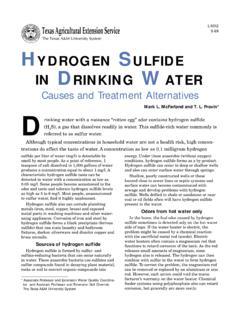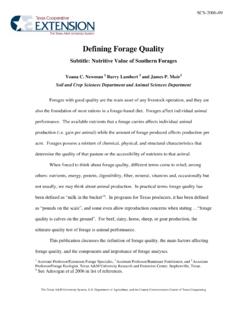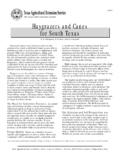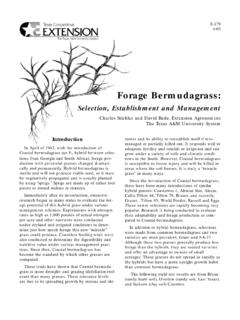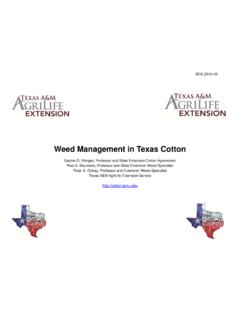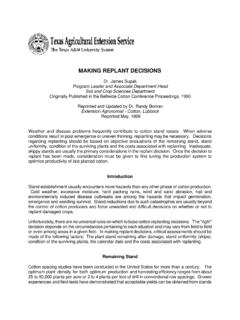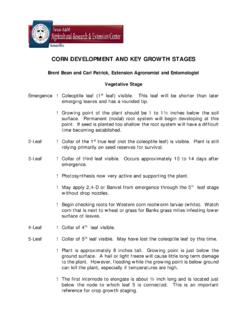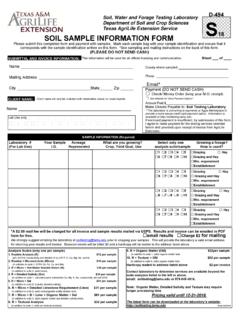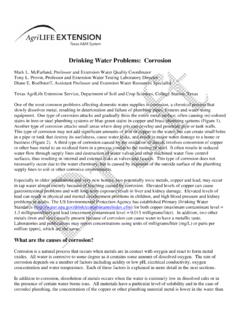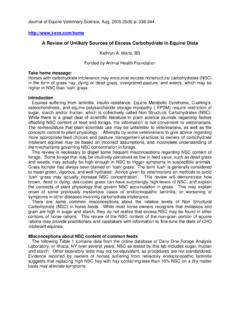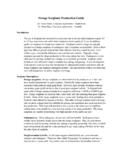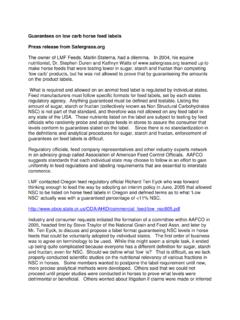Transcription of Crop Nutrient Needs in the South and Southwest …
1 B-6053. 04-01. Crop Nutrient Needs in South and Southwest Texas Charles Stichler and Mark McFarland*. Crop fertilization is not an exact science. The through crop uptake, leaching losses, or denitri- soil is a dynamic, changing, and complex fication (loss to the atmosphere). mixture of organic matter, minerals, insects, Fertilizer use efficiency the conversion nematodes, bacteria, fungi, water , and of nutrients into crop yields also changes gasses. Any change in one or more of these with yield. Low yields require fewer factors can change the availability of nutri- nutrients per pound of production than ents to plants. Much is known about how soils high yields. As the maximum yield for a and soil nutrients respond to these crop in an area is reached, the plant changes, but no one can predict precise- does not use nutrients as efficiently; so ly which changes will occur.
2 Fertility more nutrients are required to produce recommendations for essential plant each additional pound of yield. Thus, nutrients are based on averages from fertility recommendations per unit of field and laboratory tests and on what crop produced will be greater at usually works best under normal . maximum yields than at lower conditions. Special circumstances call for yields. For example, corn requires specific suggestions. pounds of nitrogen per The primary limiting factor for crop produc- bushel when yields exceed 150. tion in Texas is the availability of water . As bushels; pounds per bushel for water evaporates from a plant's leaves, yields of 100 to 150 bushels; and 1 pound the roots replace the water with soil per bushel for yields less than 100. moisture. As the roots absorb water bushels per acre.
3 Adjusting fertilizer from the soil, they also absorb nutrients rates based on realistic yield goals that are dissolved in the water . The is essential to maintain environ- more water the roots absorb, the mental quality and to obtain greater their Nutrient uptake. In dry maximum economic returns. soil, Nutrient uptake is limited, even Soil testing should be the basis for if the nutrients are present. Yield any fertility program on any crop. goals should be based on average Before buying fertilizer, producers yields on a farm, historical rainfall information, should have the soil analyzed to determine or expected water applied through irrigation. which nutrients are present in ade- Typically, nitrogen fertilization is most quate amounts, and which are important, since nitrogen is often lacking for the crop they intend to depleted from the soil each year grow.
4 The following charts provide information on when nutrients are *Associate Professor and Extension Agronomist; Associate absorbed and the approximate amounts of Professor and Soil Fertility Specialist; Texas Agricultural nutrients needed by field crops grown in South Extension Service, The Texas A&M University System. and Southwest Texas. They are not intended to serve as recommendations on the amounts of adequate fertilizer will allow the plant to reach fertilizer to apply, but can be used as a guide to its full yield potential. estimate proper application rates for crop pro- The standard nitrogen recommendation for duction at different yield levels. corn is pounds of nitrogen for each bushel produced. For example, if corn is producing 120. Corn bushels per acre, 132 pounds per acre of nitro- Corn has a high demand for nutrients because gen are needed.
5 Other nutrients should be of its high yield potential and the amount of dry applied based on a soil test. Table 1 shows matter produced. Corn yields are greatest in approximate amounts of the major nutrients regions with cool night-time temperatures; for needed based on the growth stage of the crop. this reason, yields are limited in Southwest Table 2 shows the approximate amounts of sec- Texas. With the best adapted varieties and 30 ondary and micronutrients required to produce inches of growing-season water , corn yields a corn yield of 180 bushels per acre. Table 3 is average 150 bushels per acre. With less water , the amount of nutrients removed in the grain yields are reduced in proportion to the water and returned to the soil in the stover. (The data available. Fertilizer cannot replace water in in Tables 1, 2, and 3 were adapted from the enhancing yields.)
6 However, if water is available, Phosphate and Potash Institute.). Table 1. Approximate Nutrient Requirements for Corn Based on Stage of Growth for a Yield of 180 Bushels per Acre. Days After Nitrogen Growth Stage Planting % of Total P205 % of Total K20 % of Total Early 0 - 25 19 8 4 4 22 9. Rapid Growth 25 - 50 84 35 27 27 104 44. Silk 50 - 75 75 31 36 36 72 31. Grain 75 - 100 48 20 25 25 36 14. Mature 100 - 125 14 6 8 8 6 2. Totals Harvest 240 100 240. Table 2. Approximate Total Pounds per Acre of Secondary and Micronutrients Required for a Yield of 180 Bushels per Acre of Corn. Sulfur Magnesium Calcium Iron Zinc Manganese Boron Copper 30 50 40 3 Table 3. Distribution of Nutrients Removed in Corn Grain and Stover. Crop Dry Dry Matter Nitrogen Matter Distribution % of Total P205 % of Total K20 % of Total Grain 180 bu/A 52% 170 71 70 70 48 20.
7 Stover 8,000 lbs 48% 70 29 30 30 192 80. 2. Grain Sorghum Grain sorghum is better-adapted to limited- moisture growing conditions and can produce good yields under less than optimum conditions. For a grain yield of 7,500 pounds per acre, sorghum Needs approximately 25 inches of water during the growing season. The nitrogen fertilizer recommendation in South Texas is 2. pounds of nitrogen for each 100 pounds per acre of grain yield. Estimated Nutrient require- ments for grain sorghum based on stage of growth are presented in Table 4. Tables 5 and 6. give secondary and micronutrient requirements and Nutrient distribution between grain and stover, respectively. Table 4. Approximate Nutrient Requirements for Grain Sorghum Based on Stage of Growth for a Yield of 7,500 Pounds per Acre.*. Days After Nitrogen Growth Stage Planting % of Total P205 % of Total K20 % of Total Seedling 0 - 20 9 5 2 3 18 7.
8 Rapid Growth 21 - 40 61 33 18 23 103 40. Early Bloom 41 - 60 60 32 28 33 85 33. Grain Fill 61 - 85 27 15 21 26 39 15. Maturity 86 - 95 28 15 11 14 13 5. Totals Harvest 185 80 285. Table 5. Approximate Total Pounds per Acre of Secondary and Micronutrients Required for a Grain Sorghum Yield of 7,500 Pounds per Acre.*. Sulfur Magnesium Calcium Iron Zinc Manganese Boron Copper 21 17 20 *Source: Kansas State University Table 6. Distribution of Nutrients Removed in Sorghum Grain and Stover.*. Crop Dry Dry Matter Nitrogen Matter Distribution % of Total P205 % of Total K20 % of Total Grain 7,500 lb. 56% 107 58 28 35 28 10. Stover 5,280 lb. 44% 78 42 52 65 230 80. *Source: Kansas State University 3. Cotton Because cotton is a perennial tree under its native environmental conditions (rather than an annual plant) and sets fruit throughout its growth cycle, fertility management is critical.
9 It is important to remember that more fertilizer does not always equal more yield. Too much fertilizer or application at the wrong time may even reduce yields. Other publications discuss fertility management of cotton in greater detail. Table 7 lists cotton Nutrient requirements based on growth stage, while Table 8 estimates requirements for secondary nutrients and micronutrients. Table 9 details Nutrient distribu- tion in cotton seed and stalks. Table 7. Approximate Nutrient Requirements Based on Stage of Growth to Produce 1,000. Pounds of Lint per Acre. Days After Nitrogen Growth Stage Planting % of Total P205 % of Total K20 % of Total Emergence - Seedling 0 - 15 10 8 2 3 7 6. Seedling - Early Square 15 - 35 20 14 5 8 30 25. Early Square - Early Boll 36 - 70 56 42 23 38 46 38. Early Boll - Maturity 71 - 120 48 36 31 51 37 31.
10 Totals Harvest 134 61 120. Table 8. Approximate Total Pounds per Acre of Secondary and Micronutrients Required for a Lint Yield of 1,000 Pounds per Acre. Sulfur Magnesium Calcium Iron Zinc Manganese Boron Copper 20 23 26 Table 9. Distribution of Nutrients Removed in Cotton Seed and Stalks.*. Dry Matter Nitrogen % of Total P205 % of Total K20 % of Total Seed 3,000 80 53 20 69 25 28. Stalks 3,928 70 47 9 31 59 72. *Seed and stalk totals taken from separate studies. 4. Wheat Like other grains, wheat responds to greater water and fertility with higher yield. For best utilization, timing of nitrogen applications should be split with approximately 40 percent applied preplant and 60 percent after the first of January. In South Texas, the standard recom- mendation is pounds of nitrogen per bushel per acre for ungrazed wheat; or 2 pounds of nitrogen per bushel for grazing + grain.
